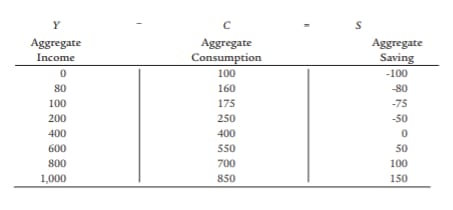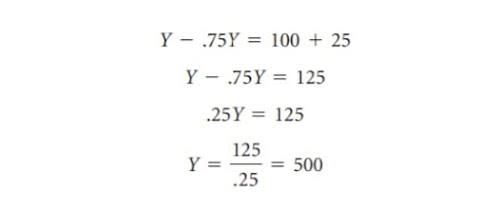Aggregate Expenditure and Equilibrium Output | MacroEconomics |CBCS
Deriving the Saving Function from the Consumption Function
Lower interest rates reduce the cost of borrowing, so lower interest rates are likely to stimulate spending.
Planned Investment (I)
The output of an economy consists not only of goods consumed by households, but investments made by firms.
The Planned Investment Function
For the time being, we will assume that planned investment is fixed. It does not change when income changes, so its graph is a horizontal line.
For this reason, there can be a difference between planned investment, which consists of the investments firms plan to make, and actual investment, which consists of all of firms’ investments, including their unplanned changes in inventories.
Firms hold planned inventories in anticipation of sales, recognising that the exact timing of sales may be uncertain. If a firm overestimates how much it will sell in a period, it will end up with more in inventory than it planned to have. On other occasions, inventories may be lower than planned when sales are stronger than expected.We will use I to refer only to planned investment. As we will see shortly, the economy is in equilibrium only when planned investment and actual investment are equal.
We now discuss the nature of equilibrium and explain how the economy achieves equilibrium.
Equilibrium - Occurs when there is no tendency for change. In the macroeconomic goods market, equilibrium occurs when planned aggregate expenditure is equal to aggregate output.
planned aggregate expenditure (AE) - The total amount the economy plans to spend in a given period. Equal to consumption plus planned investment:
AE = C + I
The economy is defined to be in equilibrium when aggregate output (Y) is equal to planned aggregate expenditure (AE).
Equilibrium: Y = AE
Because AE is, by definition, C + I, equilibrium can also be written:
Equilibrium: Y = C + I
It will help in understanding the equilibrium concept to consider what happens if the economy is out of equilibrium. First, suppose aggregate output is greater than planned aggregate expenditure:
Y > C + I
When output is greater than planned spending, there is unplanned inventory investment. Firms planned to sell more of their goods than they sold, and the difference shows up as an unplanned increase in inventories.
Next, suppose planned aggregate expenditure is greater than aggregate output:
C + I > Y
planned aggregate expenditure > aggregate output
When planned spending exceeds output, firms have sold more than they planned to. Inventory investment is smaller than planned. Planned and actual investment are not equal. Only when output is exactly matched by planned spending will there be no unplanned inventory investment.
If there is unplanned inventory investment, this will be a state of disequilibrium. Equilibrium in the goods market is achieved only when aggregate output (Y) and planned aggregate expenditure (C + I)are equal, or when actual and planned investment are equal.
Example: all our calculations are based on C = 100 + .75Y).
aggregate output > planned aggregate expenditure
Figure illustrates the same equilibrium graphically.
Figure-a adds planned investment, constant at 25, to consumption at every level of income. Because planned investment is a constant, the planned aggregate expenditure function is simply the consumption function displaced vertically by that constant amount.
Figure-b shows the planned aggregate expenditure function with the 45° line. The 45° line represents all points on the graph where the variables on the horizontal and vertical axes are equal. Any point on the 45° line is a potential equilibrium point. The planned aggregate expenditure function crosses the 45° line at a single point, where Y = 500. (The point at which the two lines cross is sometimes called the Keynesian cross.) At that point, Y = C + I.
Next, consider Y = 200. Is this an equilibrium output?
No. At Y = 200, planned aggregate expenditure is 275. Planned spending (AE) > output (Y), and there is an unplanned fall in inventory investment of 75.Firms in the aggregate will experience a different result from what they expected.
At Y = 200, planned investment and actual investment are unequal. There is unplanned investment, and the system is out of balance. Only at Y = 500, where planned aggregate expenditure and aggregate output are equal, will planned investment equal actual investment.
Equilibrium occurs when planned aggregate expenditure and aggregate output are equal. Planned aggregate expenditure is the sum of consumption spending and planned investment spending.
Finally, let us find the equilibrium level of output (income) algebraically. Recall that we know the following:
By substituting (2) and (3) into (1), we get:
There is only one value of Y for which this statement is true, and we can find it by rearranging terms:
The equilibrium level of output is 500, as shown in Table and Figure.
Feel Free to Contact,













Comments
Post a Comment